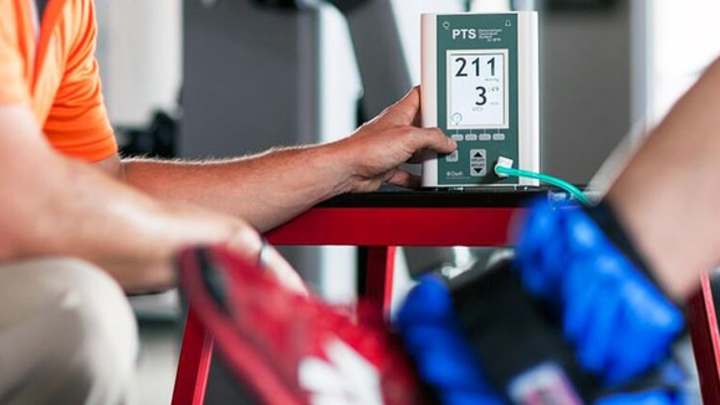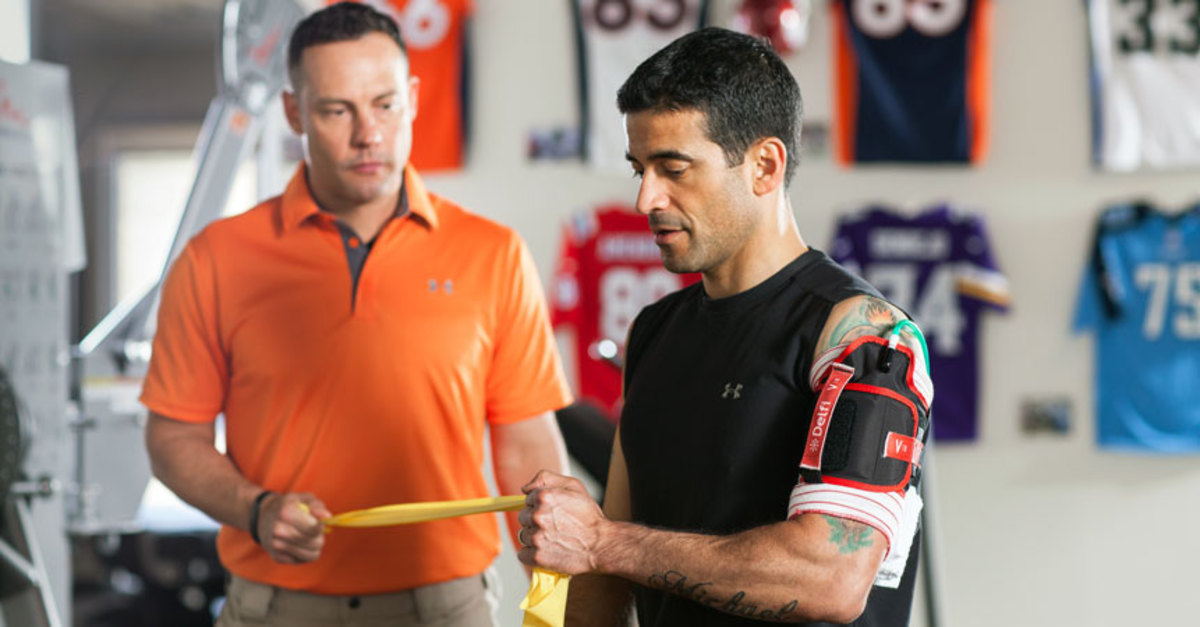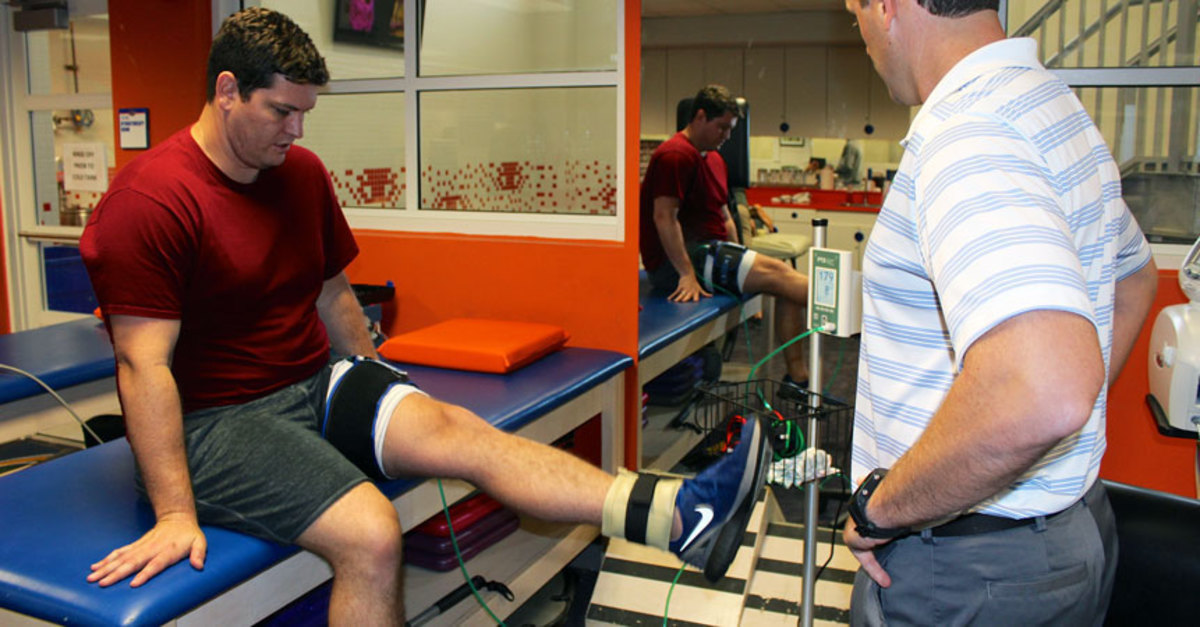Could Blood Flow Restriction training help injured athletes come back faster?

GAINESVILLE, Fla.—Paul Silvestri told me to prepare for my last set. Florida's assistant director of sports health warned me this wouldn't be easy. After three sets of leg extensions using Blood Flow Restriction training, I was inclined to believe him. Still, nothing he said could have readied me for the first rep of that final set.
"Go!" Silvestri said.
My brain told my left leg to move. It did, reluctantly. My thigh screamed exactly like it does on the final set of a workout using a Hammer Strength leg extension machine with each leg lifting 90 pounds. Yet the weight around my ankle hadn't changed since the first set. It still weighed three pounds.
Get your sportswriter-can't-lift-a-three-pound-weight jokes out of your system now. I thought Silvestri was partially kidding when he said a current Florida football player had struggled through the same workout the day before I tried it. He wasn't. After four sets (one of 30 reps followed by three of 15 reps) with that three-pound weight, I felt like my left leg had gone through a moderate leg day at the gym. I also understood much better why so many people in the sports world believe Blood Flow Restriction (BFR) training will help athletes shave valuable time off their injury rehabilitation and could help them come back from injury even stronger.
Florida is the first college athletic program to use BFR training, joining 13 NFL and NBA teams that have adopted the method in the past year. But the concept that helped Jadeveon Clowney return to the field for the Houston Texans has its roots in a far more serious world than sports.
BFR training is also known as tourniquet training. It is not a new concept. Scientists have studied it for decades, but athletic trainers and physical therapists have only recently begun using it to help patients heal faster. The concept is shockingly simple, even if the equipment involved is advanced. A cuff—similar to the ones used to check blood pressure—is placed either on the thigh or around the upper arm. The injured person does several sets of exercises using very light weights. Because the blood supply is cut off, the mind believes that the body is working much harder than it is. This triggers a physiological response that tells the body to begin repairing the area below the cuff.

Owens Recovery Science
"It's a signal that's telling your body you did something crazy and hard," said Johnny Owens of Owens Recovery Science, the company that supplied Florida with its BFR equipment and showed the athletic training staff how to use it. "Once that signal kicks in, it's basically a monitoring system. These little nerves go to your brain, and they say 'start releasing growth hormone' and 'start kicking in protein synthesis.'"
Owens began using BFR therapy about four years ago in his role as chief of human performance at the Center for the Intrepid, a rehabilitation facility at Fort Sam Houston in Texas that helps soldiers who have suffered severe injuries in battle. Owens worked with the Limb Salvage Group, whose mission was simple: Try to keep soldiers who have suffered major trauma to their limbs from having to get those limbs amputated. "Their limbs were so mangled that they were going to have to make a decision," Owens said. "Do I want to keep it or cut it off? The ones that kept it came over to my world. We were looking at any kind of new technology we could use to keep them from cutting their limbs off."
Owens lost sleep over his patients. It crushed him when a soldier or veteran decided, after months or years of failed rehab, to have his injured limb amputated. There had to be a better way, Owens thought. That better way was BFR. After reading about the concept, Owens wondered if constricting blood flow might be the answer to his most pressing dilemma. His patients' limbs were so compromised. A soldier whose leg was mangled by an improvised explosive device wasn't going to be able to squat 225 pounds for three sets of 10 reps. He couldn't do leg extensions with 90 pounds on each leg. The team at the Center for the Intrepid built an exoskeleton that could act like a prosthetic, and that helped some patients. But others weren't strong enough to use the device, which was made of carbon and Kevlar and required a baseline level of strength to operate. "We were running into a wall because of that," Owens said.
Owens needed those seriously injured patients' minds to believe their legs or arms were working hard in order to convince their minds to send the necessary signals and hormones to grow muscle. "Your body does not like to put on muscle," Owens said. "That's just an evolutionary thing. If you just did any little activity and your body put on muscle, then you would have to find more food because muscle is so metabolically expensive. We've come to this point where the body does anything it can to avoid using those fast-twitch fibers. If you do something really hard, your body will use those fast-twitch fibers." But some patients simply couldn't use those fibers because of the severity of their injuries. "There was nothing they could do that was ever going to activate them," Owens said. "They couldn't lift heavy enough. They couldn't sprint."
Owens theorized that by using BFR to force the body into an anaerobic (no oxygen reaching the muscles) state while using minimal weight, it could trick the mind into creating muscle without placing undue stress on an injured area. His first test group gave him confidence. In a paper published this spring in the Journal of Special Operations Medicine, Owens and his fellow authors detailed a test group of seven members of the Limb Salvage Group. One man was a 29-year-old who, in 2010, suffered open fractures of his left tibia and fibula because of an IED blast. After two weeks of BFR therapy, his peak torque improved by 26%, his power improved by 33% and his total work improved by 25%. Other patients had similar results, and Owens knew he had found a way to help save some of his patient's limbs.
On Veteran's Day 2014, ESPN ran a story by Stephania Bell profiling Owens's work at Fort Sam Houston. That led to a call from the Texans, who became Owens's first sports client and used BFR to help Clowney rehab from knee surgery.
The Texans medical staff recognized quickly that BFR training could benefit athletes who typically weren't nearly as injured as the soldiers with whom Owens worked. Clowney was coming off major surgery, but how would BFR work for a player who had a relatively simple arthroscopic procedure to clean up knee cartilage? How much faster could he return? "Does it save two days?" Florida's Silvestri said. "Two days in our world is a big deal. Does it save a week?"
When a player is injured, he is usually ordered to stop training the affected area to avoid aggravating the injury or stunting the healing process. This lack of activity causes muscle atrophy. With BFR, the weights are so light that the injured area is barely stressed at all. The mind, however, thinks the affected area is undergoing a full-scale workout. Thanks to the mind's confusion, the body reacts accordingly. The day after I tried a BFR workout, my left leg was as sore as it would have been after a moderate lower-body weight workout.

Andy Staples
Owens said his team has seen patients not only keep their muscles from atrophying; they have actually grown muscle around the injured area. "When you activate those fibers," Owens said, "it wakes that whole muscle up." Several of his severely injured military patients told Owens their legs felt "alive again."
So, why did it take so long for BFR training to gain acceptance? Fear. Constricting blood flow and lifting weights is inherently dangerous if not monitored and done in moderation. Do not, for example, read this story, buy a blood pressure cuff and start doing curls. Owens uses thin cuffs that constantly monitor blood pressure and adjust to maintain a set pressure. He won't sell equipment to a team unless he can personally train the medical staff on its proper use. Also, his patients only do a few exercises with very light weights. Someone lifting weights while using a tourniquet might suffer nerve damage after a few hours. The patients who use Owens's methods rarely work for more than 15 minutes.
But the mind and body don't know that. They think the injured soldier or athlete has completed a full workout, and they begin repairing the damage caused by using fast-twitch fibers without much oxygen. "We're following the pathway," Owens said. "We just got you there quicker and tricked it a little bit."
It remains to be seen whether having BFR available in the training room will help any of Florida's players return from injury faster, but Silvestri is optimistic. "These are all kind of like our patient zeros," he said. "We're trying to see where we are compared to the old days." Meanwhile, Owens continues to field calls from teams hoping to add BFR training to their rehabilitation menus. After using the system for a short time, Silvestri understands why. "We get a lot of pitches for new gadgets and new therapies," he said. "This one you feel good about because of the science behind it."
